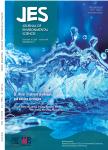Size distribution of the secondary organic aerosol particles from the photooxidation of toluene
Size distribution of the secondary organic aerosol particles from the photooxidation of toluene作者机构:Laboratory of Environmental Spectroscopy Anhui Institute of Optics and Fine Mechanics Chinese Academy of Sciences Hefei 230031 China
出 版 物:《Journal of Environmental Sciences》 (环境科学学报(英文版))
年 卷 期:2005年第17卷第6期
页 面:912-916页
核心收录:
学科分类:07[理学] 070602[理学-大气物理学与大气环境] 0706[理学-大气科学]
主 题:toluene hydroxyl radical secondary organic aerosol smog chamber
摘 要:In a smog chamber, the photooxidation of toluene was initiated by hydroxyl radical (OH.) under different experimental conditions. The size distribution of secondary organic aerosol(SOA) particles from the above reaction was measured using aerodynamic particle sizer spectrometer. It was found from our experimental results that the number of SOA particles increased with increasing the concentration of toluene. As the reaction time prolonged, the sum of SOA particles was also increased. After a reaction time of 130 min, the concentration of secondary organic aerosol particles would be kept constant at 2300 particles/cm^3. Increasing illumination power of blacklamps could significantly induce a higher concentration of secondary organic aerosol particle. The density of SOA particles would also be increased with increasing concentration of CH30NO, however, it would be decreased as soon as the concentration of CH30NO was larger than 225.2 ppm. Nitrogen oxide with initial concentration higher than 30. 1 ppm was also found to have little effect on the formation of secondary organic aerosol.



